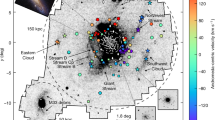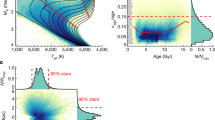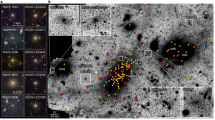Abstract
The halo of the Milky Way provides unique elemental abundance and kinematic information on the first objects to form in the Universe, and this information can be used to tightly constrain models of galaxy formation and evolution. Although the halo was once considered a single component, evidence for its dichotomy has slowly emerged in recent years from inspection of small samples of halo objects. Here we show that the halo is indeed clearly divisible into two broadly overlapping structural components—an inner and an outer halo—that exhibit different spatial density profiles, stellar orbits and stellar metallicities (abundances of elements heavier than helium). The inner halo has a modest net prograde rotation, whereas the outer halo exhibits a net retrograde rotation and a peak metallicity one-third that of the inner halo. These properties indicate that the individual halo components probably formed in fundamentally different ways, through successive dissipational (inner) and dissipationless (outer) mergers and tidal disruption of proto-Galactic clumps.
This is a preview of subscription content, access via your institution
Access options
Subscribe to this journal
Receive 51 print issues and online access
$199.00 per year
only $3.90 per issue
Buy this article
- Purchase on Springer Link
- Instant access to full article PDF
Prices may be subject to local taxes which are calculated during checkout





Similar content being viewed by others
References
Hartwick, F. D. A. in The Galaxy (eds Gilmore, G. & Carswell, B.) 281–290 (NATO ASI Series 207, Reidel, Dordrecht, 1987)
Zinn, R. in The Globular Clusters-Galaxy Connection (eds Smith, G. H. & Brodie, J. P.) 38–47 (ASP Conf. Ser. 48, Astronomical Society of the Pacific, San Francisco, 1993)
Preston, G. W., Shectman, S. A. & Beers, T. C. Detection of a galactic color gradient for blue horizontal-branch stars of the halo field and implications for the halo age and density distributions. Astrophys. J. 375, 121–147 (1991)
Kinman, T. D., Suntzeff, N. B. & Kraft, R. P. The structure of the galactic halo outside the solar circle as traced by the blue horizontal branch stars. Astron. J. 108, 1722–1772 (1994)
Miceli, A. et al. Evidence for distinct components of the Galactic stellar halo from 838 RR Lyrae stars discovered in the LONEOS-I survey. Astrophys. J.. (in the press); preprint at 〈http://arxiv.org/abs/0706.1583〉 (2007)
Majewski, S. R. A complete, multicolor survey of absolute proper motions to B of about 22.5 – Galactic structure and kinematics at the north Galactic pole. Astrophys. J. 78 (Suppl.). 87–152 (1992)
Carney, B. W., Laird, J. B., Latham, D. W. & Aguilar, L. A. A survey of proper motion stars. XIII. The halo population(s). Astron. J. 112, 668–692 (1996)
Wilhelm, R. et al. in Formation of the Galactic Halo... Inside and Out (eds Morrison, H. & Sarajedini, A.) 171–174 (ASP Conf. Ser. 92, Astronomical Society of the Pacific, San Francisco, 1996)
Kinman, T. D., Cacciari, C., Bragaglia, A., Buzzoni, A. & Spagna, A. Kinematic structure in the Galactic halo at the north Galactic pole: RR Lyrae and BHB stars show different kinematics. Mon. Not. R. Astron. Soc. 371, 1381–1398 (2007)
Lee, Y.-W., Hansung, B. G. & Casetti-Dinescu, D. I. Kinematic decoupling of globular clusters with extended horizontal branches. Astrophys. J. 661, L49–L52 (2007)
York, D. G. et al. The Sloan Digital Sky Survey: Technical summary. Astron. J. 120, 1579–1587 (2000)
Adelman-McCarthy, J. K. et al. The fifth data release of the Sloan Digital Sky Survey. Astrophys. J. Suppl. 172 634–644 (2007)
Sandage, A. & Fouts, G. New subdwarfs. VI. Kinematics of 1125 high-proper-motion stars and the collapse of the Galaxy. Astron. J. 92, 74–115 (1987)
Ryan, S. G. & Norris, J. E. Subdwarf studies. II – Abundances and kinematics from medium-resolution spectra. III. – The halo metallicity distribution. Astron. J. 101, 1835–1864 (1991)
Chiba, M. & Beers, T. C. Kinematics of metal-poor stars in the Galaxy. III. Formation of the stellar halo and thick disk as revealed from a large sample of non-kinematically selected stars. Astron. J. 119, 2843–2865 (2000)
Carney, B. W. in The Third Stromlo Symposium: The Galactic Halo (eds Gibson, B. K., Axelrod, T. S. & Putman, M. E.) 230–242 (ASP Conf. Ser. 165, Astronomical Society of the Pacific, San Francisco, 1999)
Majewski, S. R., Munn, J. A. & Hawley, S. L. Absolute proper motions to B approximately 22.5: Evidence for kimematical substructure in halo field stars. Astrophys. J. 427, L37–L41 (1994)
Sirko, E. et al. Blue horizontal-branch stars in the Sloan Digital Sky Survey. I. Sample selection and structure in the Galactic halo. Astron. J. 127, 899–913 (2004)
Binney, J. & May, A. The spheroids of galaxies before and after disc formation. Mon. Not. R. Astron. Soc. 218, 743–760 (1986)
Sommer-Larsen, J. & Zhen, C. Armchair cartography – A map of the Galactic halo based on observations of local, metal-poor stars. Mon. Not. R. Astron. Soc. 242, 10–24 (1990)
Eggen, O. J., Lynden-Bell, D. & Sandage, A. R. Evidence from the motions of old stars that the galaxy collapsed. Astrophys. J. 136, 748–766 (1962)
Searle, L. & Zinn, R. Compositions of halo clusters and the formation of the galactic halo. Astrophys. J. 225, 357–379 (1978)
White, S. D. M. & Rees, M. J. Core condensation in heavy halos – A two-stage theory for galaxy formation and clustering. Mon. Not. R. Astron. Soc. 183, 341–358 (1978)
Moore, B., Diemand, J., Madau, P., Zemp, M. & Stadel, J. Globular clusters, satellite galaxies and stellar haloes from early dark matter peaks. Mon. Not. R. Astron. Soc. 368, 563–570 (2006)
Bullock, J. S. & Johnston, K. V. Tracing galaxy formation with stellar halos. I. Methods. Astrophys. J. 635, 931–949 (2005)
Abadi, M. G., Navarro, J. F. & Steinmetz, M. Stars beyond galaxies: The origin of extended luminous haloes around galaxies. Mon. Not. R. Astron. Soc. 365, 747–758 (2006)
Brook, C. B., Kawata, D., Martel, H., Gibson, B. K. & Scannapeico, E. Chemical and dynamical properties of the stellar halo. EAS Publ. Ser. 24, 269–275 (2007)
Fukigita, M. et al. The Sloan Digital Sky Survey photometric system. Astron. J. 111, 1748–1756 (1996)
Gunn, J. E. et al. The Sloan Digital Sky Survey photometric camera. Astron. J. 116, 3040–3081 (1998)
Pier, J. R. et al. Astrometric calibration of the Sloan Digital Sky Survey. Astron. J. 125, 1559–1579 (2003)
Gunn, J. E. et al. The 2.5 m telescope of the Sloan Digital Sky Survey. Astron. J. 131, 2332–2359 (2006)
Bell, E. F. et al. The accretion origin of the Milky Way’s stellar halo. Astrophys. J (in the press); preprint at 〈http://arxiv.org/abs/0706.0004〉 (2007)
Majewski, S. R. Galactic structure surveys and the evolution of the Milky Way. Annu. Rev. Astron. Astrophys. 31, 575–638 (1993)
Bekki, K. & Chiba, M. Formation of the galactic stellar halo. I. Structure and kinematics. Astrophys. J. 558, 666–686 (2001)
Chiba, M. & Beers, T. C. Structure of the galactic stellar halo prior to disk formation. Astrophys. J. 549, 325–336 (2001)
Belokurov, V. et al. The field of streams: Sagittarius and its siblings. Astrophys. J. 642, L137–L140 (2006)
Belokurov, V. et al. Cats and dogs, hair and a hero: A quintet of new Milky Way companions. Astrophys. J. 654, 897–906 (2007)
Dekel, A. & Woo, J. Feedback and the fundamental line of low-luminosity low-surface-brightness/dwarf galaxies. Mon. Not. R. Astron. Soc. 344, 1131–1144 (2003)
Quinn, P. J. & Goodman, J. Sinking satellites of spiral systems. Astrophys. J. 309, 472–495 (1986)
Norris, J. E. & Ryan, S. G. Population studies: Evidence for accretion of the galactic halo. Astrophys. J. 336, L17–L19 (1989)
Christlieb, N. et al. A stellar relic from the early Galaxy. Nature 419, 904–906 (2002)
Frebel, A. et al. Nucleosynthetic signatures of the first stars. Nature 434, 871–873 (2005)
Norris, J. E. et al. HE 0557–4840 – ultra metal-poor and carbon-rich. Astrophys. J. 670, 774–788 (2007)
Bonifacio, P. et al. First stars VII. Lithium in extremely metal-poor dwarfs. Astron. Astrophys. J. 462, 851–864 (2007)
Lucatello, S. et al. The frequency of carbon-enhanced metal-poor stars in the Galaxy from the HERES sample. Astrophys. J. 653, L37–L40 (2006)
Frebel, A. et al. Bright metal-poor stars from the Hamburg/ESO Survey. I. Selection and follow-up observations from 329 fields. Astrophys. J. 652, 1585–1683 (2006)
Tumlinson, J. Carbon-enhanced metal-poor stars, the cosmic microwave background, and the stellar IMF in the early universe. Astrophys. J. (submitted)
Frenk, C. S. & White, S. D. M. The kinematics and dynamics of the galactic globular cluster system. Mon. Not. R. Astron. Soc. 193, 295–311 (1980)
Acknowledgements
We thank C. Allende Preito, E. Bell, W. Brown, A. Frebel, B. Gibson, H. Morrison, C. Thom, J. Tumlinson and B. Yanny for comments on previous versions of this Article. D.C. acknowledges partial support for travel and living expenses from JINA, the Joint Institute for Nuclear Astrophysics, while in residence at Michigan State University. Funding for the SDSS and SDSS-II has been provided by the Alfred P. Sloan Foundation, the Participating Institutions, the National Science Foundation, the US Department of Energy, the National Aeronautics and Space Administration, the Japanese Monbukagakusho, the Max Planck Society, and the Higher Education Funding Council for England. The SDSS website is http://www.sdss.org.
Author information
Authors and Affiliations
Corresponding author
Supplementary information
Supplementary Information
This file presents details concerning the selection of the stars used in this analysis, as well as for the derivation of the stellar atmospheric parameters, and for the derivation of the kinematic parameters. Additional kinematic analyses are also reported. The file contains Supplementary Notes, Supplementary Tables 1-2 and Supplementary Figures 1-6 with Legends. (PDF 1206 kb)
Rights and permissions
About this article
Cite this article
Carollo, D., Beers, T., Lee, Y. et al. Two stellar components in the halo of the Milky Way. Nature 450, 1020–1025 (2007). https://doi.org/10.1038/nature06460
Received:
Accepted:
Issue Date:
DOI: https://doi.org/10.1038/nature06460
This article is cited by
-
A stellar clock reveals the assembly history of the Milky Way
Nature (2022)
-
Modelling the chemical evolution of the Milky Way
The Astronomy and Astrophysics Review (2021)
-
Kinematics and Velocity Ellipsoid of Halo Red Giants
Astrophysics (2020)
-
De re metallica: the cosmic chemical evolution of galaxies
The Astronomy and Astrophysics Review (2019)
-
The merger that led to the formation of the Milky Way’s inner stellar halo and thick disk
Nature (2018)
Comments
By submitting a comment you agree to abide by our Terms and Community Guidelines. If you find something abusive or that does not comply with our terms or guidelines please flag it as inappropriate.



